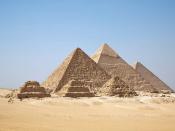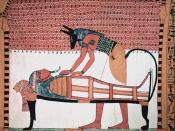The Egyptian process of embalming, or mummification, is very interesting. Using special processes, the Egyptians would drain the moisture from the dead body, leaving a dried out carcass that would not easily decay. In the Egyptian religion, it was important to keep the body as life-like as possible. So successful were they that you can look at the body of a 3000-year-old mummy and have a good idea of what they looked like. This is what you will learn, and more, in the rest of my report. Enjoy!
Mummification was practiced throughout Egyptian history. The earliest mummies from prehistoric times were probably accidental. By chance, the sand and dry air preserved some bodies in shallow pits dug into the sand. About 2600 B.C.E., during the fourth and fifth dynasties, Egyptians began to mummify intentionally. The practice continued and developed for well over 2000 years, into the Roman period. Within any one period the mummification varied, depending on the price paid for it.
The best-preserved mummies are the eighteenth through the twentieth dynasties of the New Kingdom, and include those of Tutankhamen and other well-know pharaohs. The history of mummification is interesting, huh?
The mummification process took at least seventy days. Special priests worked as embalmers, treating and wrapping the body. Besides knowing the correct rituals and prayers to be performed at various stages of the mummification process, the priests also needed a detailed knowledge of human anatomy. The first step in the mummification process was the removal of all internal parts that might decay rapidly. The brain was removed by carefully inserting special hooked instruments up the nostrils to pull out bits of brain tissue. It was a delicate operation, one that could easily ruin the face, a terrible thing in the Egyptian afterlife. The embalmers then removed the...


